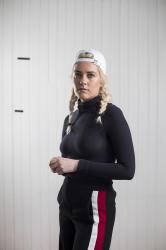Boff Konkerz did his first tattoo on the most tattooed man in the world, Lucky Diamond Rich. “By a series of random events I ended up sharing a room with him and a tattooist in London and they showed me how to do one.” He laughs while telling me the story. “It’s far out really. It was twelve years ago so we didn’t even take a picture of it. We just did it one night and said, ‘Hm, that’s good.’”
Machine-Free Tattooing
Boff is energetic, talkative and likable. As we start to chat, I instantly feel comfortable around him—a welcome feeling considering that I’m lying on his table about to get inked. Konkerz isn’t your average tattooer, though. No, instead of using a tattoo machine—which vibrates up and down, pressing the ink via needles into your skin—Boff practices what he calls, “Machine-Free Tattooing.” Using a special handmade tool of wood, tape, and needles, Boff hand taps each individual dot into a client himself. “Most laymen wouldn’t be able to tell the difference,” he tells me, “but to someone who really knows tattoos it’s everything.”
I decide to get a piece on my ribs. Boff is a little hesitant—rib tattoos hurt like hell—but he reluctantly allows it after I show him my other tattoos. Konkerz works in the Íslenska Húðflúrstofan shop and specializes in Icelandic tattoos. “Vegvísir. Vegvísirs undeniably,” he answers when I ask him what his most popular request is. A vegvísir is an Icelandic stave that represents a compass—you might have seen it on Björk’s arm. He laughs. “I’ve done multiple ones today actually.”
Wanting to give him a little vegvísir-breather, I decide on a runic wheel of luck. Boff quickly puts the stencil on, waits for my approval, and then begins. I don’t know what I was expecting, but right off the bat I notice that machine-free tattooing is significantly less painful than the traditional method. While I commonly compare getting a tattoo by a machine to a feeling in between a drill and a bee-sting, this feels like a bunch of fast jolts. It is extraordinarily less intense. I tell Boff that I can normally last about four hours of machine tattooing before I tap out, but that I think I could sit for this all day. Boff tells me this is common response.





Punk Rock Tattooing
As we continue with the stave, Boff regals me with tales of his life. Originally, he tells me, he saw tattooing only as a hobby: “Yeah, I was doing them in a very punk-rock style on friends and acquaintances, but over the years I got really good at it.” He was then offered a job in a studio, which he took and later quit. “It was kind of like a 9 to 5 there, you know?” He smiles. “It wasn’t for me.” After that, he began traveling the world, doing guest spots everywhere from Denmark to America.
That’s how he ended up in Iceland. “[Traveling] gets tiring,” he says. “You just think, ‘fuck this,’ and my girlfriend is from here and I like it here so we moved here and everything has been going great.” His girlfriend, by the way, has also learned machine-free tattooing and has started working at the shop too. “So I think by virtue of us both being here,” he tells me, “Iceland probably has the most amount of professional hand-poked tattooists per head population in the world.” He laughs. He’s probably right.
We finally finish the tattoo and I look in the mirror. The wheel of luck is delicate and beautiful. I’m instantly in love. For my next tattoo, I’m hoping to get a large colour portrait—maybe Boff would be interested in picking up a machine? He raises his eyebrows as he tapes my piece in cellophane. “Nope. Never.”

Buy subscriptions, t-shirts and more from our shop right here!
















